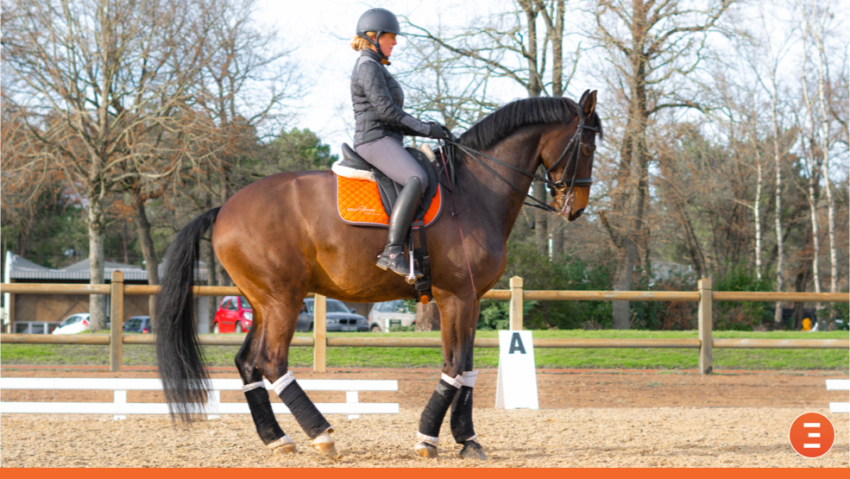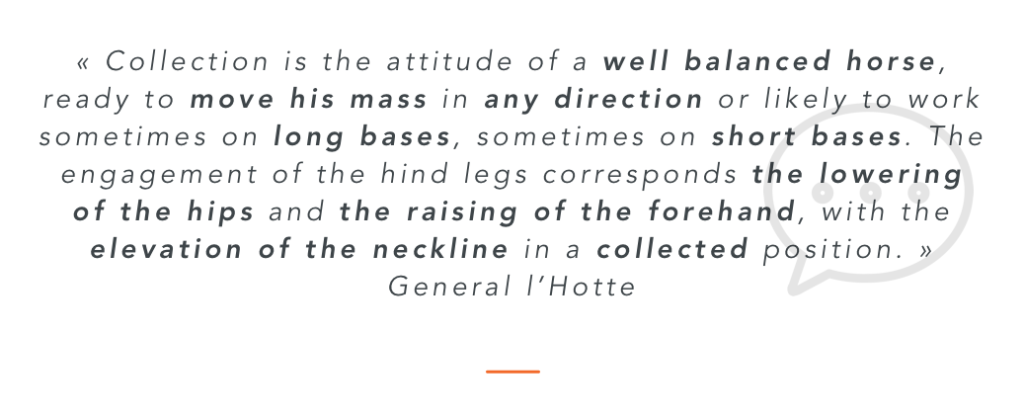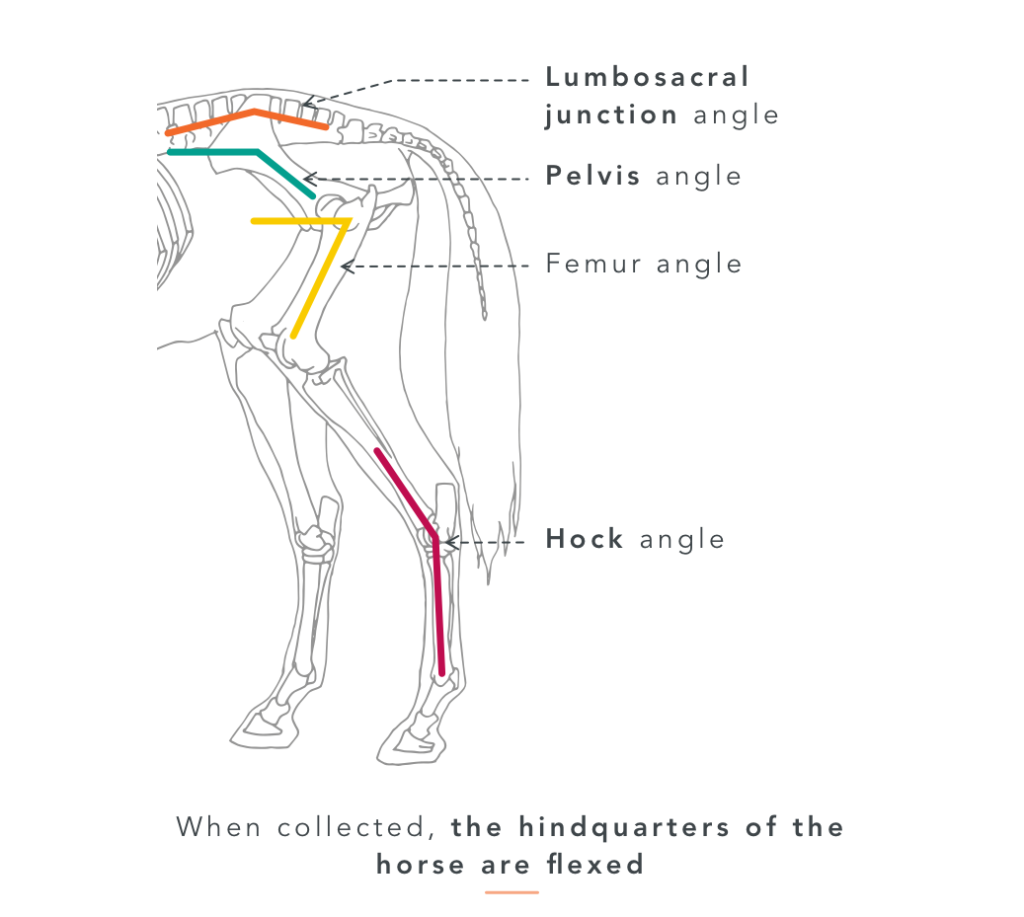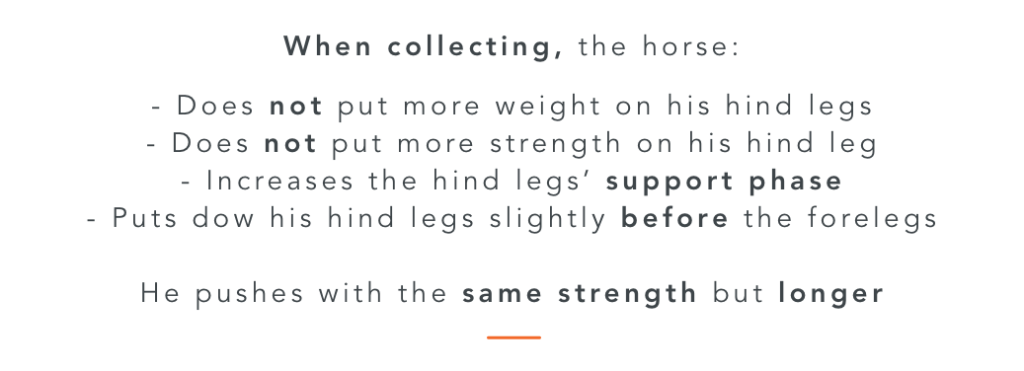
10 Things you did not Know About Collecting Your Horse
Collecting a horse can sometimes be a bit scary. Jumping riders will say that collection is only for dressage. Dressage riders will say that they are struggling to collect their horse. But in reality, not many people are able to say what it REALLY means to collect a horse, and why we do it. So let’s have a look at the 10 things you did not know about collecting your horse.
Table des matières
Let’s contextualize all this
So, in what circumstances does your trainer whisper “Put more weight on the hind legs” ? Often when the movement you’re in requires some kind of collection. And just like that, thunderclap, the word that scares everyone has just been dropped.
1 – What is collection?
Finding a good definition of collecting is not an easy task. The only one that seems to be unanimous is the one of “the Manual of Equitation” [1] which quotes General l’Hotte:

2 – Why is it good for the horse to be collected?
If one translates General L’hotte’s definition into simpler english, collection is in fact an attitude which helps the horse moving with greater ease [2].
Indeed, the engagement of the hindquarters, the lowering of the hips and the raising of the front hand will cause a lowering and a receding of the center of gravity which makes the horse gain on mobility.
When collected, it will be easier for the horse to change his trajectory and speed. This is goes for the dressage horses but also for the jumping and cross country horses!
3 – What differences can be seen when the horse is collected?
In fact, the differences are multiple.
The hindquarters bend more
All articulated angles at the level of the hind legs close. This going from the lumbosacral junction to the fetlock [3] [4]
The hind legs are therefore much more solicited. Muscly speaking, collection is very difficult for the horse.
📚 Read more: Here is how to get your horse’s hindquarters muscled

The locomotion changes [3] [4] [5] [6] [7] [8]
One would have suspected it, but I confirm it to you: when the horse is collected, his speed decreases and so does his ground covering. Strides last longer so the cadence decreases…
By the way, don’t forget to use Equisense Motion Sport to measure your horse’s rhythm and regularity!

📚 Read more: Cadence, speed, and stride length
On the other hand what is rather surprising, is that despite the impression of lightness and the aerial gestures felt through out collection, it is not due to the horse staying longer above the ground. It’s even the opposite, the support phase is actually longer.
When a horse is collected, the gesture (limb trajectory) also changes. In fact, the limbs move less forward, less backward and slower!
4 – What is the link between collection and weight on the hindquarters?
Visually, the flexion of the hind legs, the modification of their trajectory and the lengthening of the of the support phase give us the impression that the horse carries more weight in his hind legs. When actually … this is wrong and even doubly wrong! (But it’s a little bit of real anyway)
The horse does not put more weight on his hind legs [2]
Imagine that the hinds of your horse represent a mass of 200 kg. Whether your horse is in collected or not, they will always weigh … 200kg. Their mass (or their weight) remains the same. So no, there is not more weight on the hind legs.
Moreover, small note, at rest, it is the forelegs that support the majority (55 to 65%) of the horse’s weight.
The horse does not put more strength on his hind legs [4] [5]
When your trainer talks about “weight on the hind legs”, you might think of strength on the hind legs.
And here again it’s wrong, collection does not mean more strength. When comparing a working trot and a collected trot, the horse will apply the same strength. Basically, he does not need to put more strength on his hind legs to be collected.
However, as the support phase of the stride takes longer, we can say that the horse pushes with the same strength but longer!
Increase of the effort [4] [7]
In fact, the effort is the result of the product strength x support time. Strength does not increase, but the effort will.
If you look at the difference between forelegs and hind legs, the effort will increase more by the hind legs than the forelegs.
During collected trot, 58% of the effort is developed by the forelegs, and it drops to 55% during changes [4]. There is a very slight redistribution of the effort from forelegs to the hind legs. However, the effort remains more important on the forelegs.
The hind legs touch the ground before the forelegs
In fact, when the horse is collected we can observe a dissociation of the diagonals. When collected, the hind legs will touch the ground a little before the forelegs. We’re talking about a few milliseconds which is not visible to the eye. Because the hind legs land a little before, their support time will last longer than the forelegs, so their effort (strength x support time) will increase.

Summary
The 10 points to remember:
- Collection it is an attitude that helps the horse to move with greater ease
- When the horse is collected, all his articular angles at the level of the hindquarters are closed
- Collection, decreases speed
- Collection decreases ground covering
- Strides last longer so the cadence decreases
- Support phase is lengthened
- The horse does not put more weight in his hind legs when he is collected
- He also does not put more strength on them
- The support phase of the hind legs increases due to touching the ground before the forelegs
- The horse puts the same force but for a longer period of time
17 exercises to collect your horse
After saying all that, I can not leave without some small preparatory exercises! I have prepared 17 exercises, good for dressage horses but also jumping and cross country horses!
This program is available on our Equisense App. It’s free and you can use it even without a sensor! Get it now!
Conclusion
Next time your trainer says “put more weight in the hind legs” you can answer: “No, I cannot put more weight on the hind legs, but I can try to increase the hind legs flexion and the support phase duration “.
Until next article,
Camille Saute,
Resp. R&D at Equisense
Bibliography
[1] FEDERATION FRANCAISE DES SPORTS EQUESTRES, Manuel d’équitation, Editions Charles-Lavauzelle, 1974.
[2] S. BIAU, C. SAUTE, and I. BURGAUD, “La biomécanique du rassembler,” in Les 2eme rencontres de l’équitation de tradition française, Saumur, Octobre 2015.
[3] M. HOLMSTRÖM, I. FREDERICSON et S. DREVEMO, «Biokinematic effects of collection on the trotting gaits in the elite dressage horse,» Equine Veterinary Journal, vol. 27, n°4, pp. 281-287, 1995.
[4] M. A. WEISHAUPT, A. BYSTRÖM, K. von PEINEN, T. WIESTNER, H. MEYER, N. WALDERN, C. JOHNSTON, R. van WEEREN et L. ROEPSTORFF, «Kinetics and kinematics of the passage,» Equine Veterinary Journal, vol. 43, n°3, pp. 263-267, 2000
[5] M. HOLMSTRÖM et S. DREVEMO, «Effects of trot quality and collection on the angular velocity in the hindlimb of riding horses,» Equine Veterinary Journal, Suppl. 23, pp. 62-65, 1997.
[6] H. M. CLAYTON, «Comparison of the stride kinematics of the collected, working, medium and extended trot in horses,» Equine Veterinary Journal, vol. 26, n°3, pp. 230-234, 1994.
[7] S. BIAU, «Contribution à l’expertise de la locomotion du cheval de dressage par une méthode accélérométrique,» Poitiers, 2002.
[8] H. M. CLAYTON, «Classification of collected trot, passage and piaffe based on temporal variables.,» Equine Veterinary Journal, Suppl 23, pp. 54-57, 1997.
Illustration
Bubble by iconfun from the Noun Project